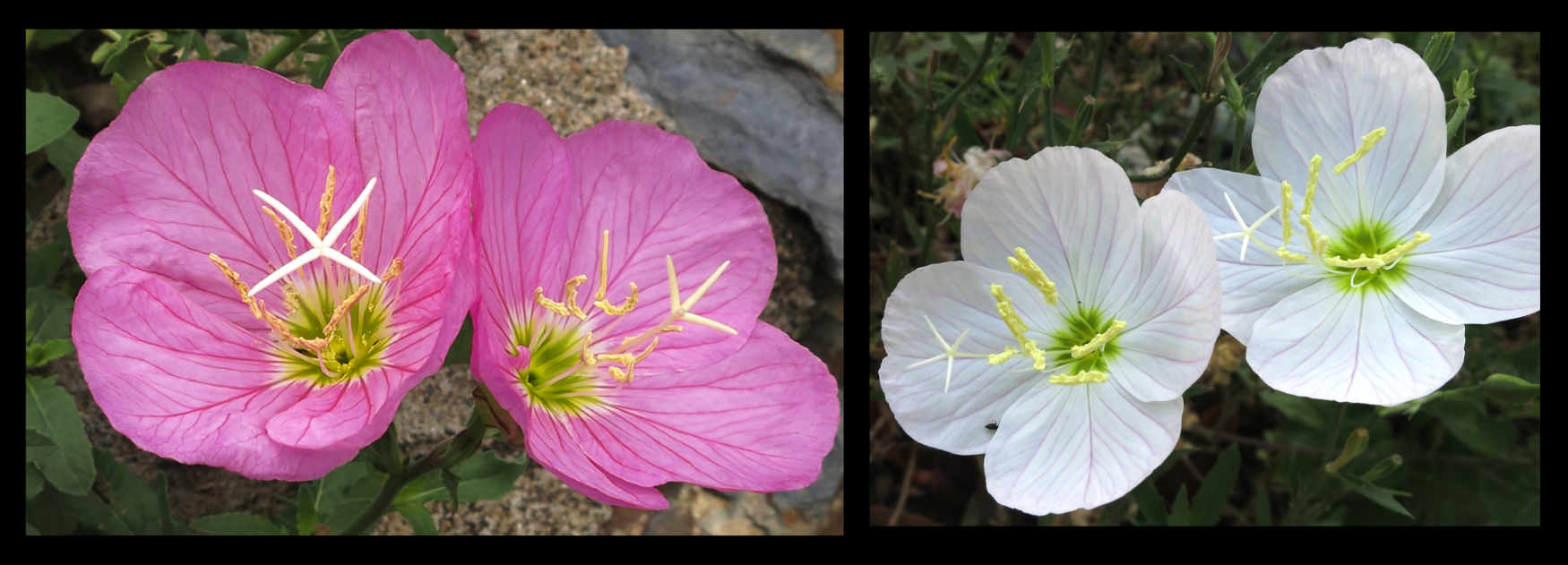Oenothera.
Family Onagraceae > Subfamily > Onagroideae Tribe > Onagreae.
Plants of the World Online recognises 157 species while others say 120 to 150.
Native to North and South America they are known as Evening Primrose.
Most are annual, biennial or perennial herbs from 10 cm up to 2.5 or 3 m high.
Those with a taproot tend to be erect plants that may have a slightly woody base (sub-shrubs).
Those with fibrous roots can spread on the ground for around 60 cm forming mounds.
The erect to prostrate stems are thin with few or no branches.
The few to dense hairs can be fine or coarse, spreading or lying along the surface and simple or glandular.
The alternately arranged leaves are typically in two sections.
In the tight basal rosette the petioles are 0.5 to 2 cm long and the narrow elliptic to oblanceolate blades are up to 8 cm.
The edge can be smooth, have small teeth or have lobes, usually at the base that extend half way to the midrib.
The stalk and blade have short and or long hairs.
Some plants have no rosette and in others it may die off when the plant flowers.
The more widely spaced leaves along the stem are the cauline leaves.
The lower leaves have a short petiole to 1 cm long while the upper ones have none.
The ovate, elliptic or lanceolate lower cauline blades can be up to 18 cm long and 4 cm wide.
The leaves get smaller towards the top of the stem.
They can have a smooth edge, a few to many small teeth and a few lobes at the base.
There are usually short fine or long hairs.
The terminal inflorescences, of alternately arranged flowers can be a short cluster
or they can be spread out along the stem in a spike.
They often have no stalk but all have a small leaf-like bract at the base.
Many parts have short stiff hairs that lie flat along the surface.
Flowers open during the day or in the evening.
The hypanthium is formed from the sepal, petal and stamen bases.
It is often long being up to 7 or even 15 cm but can be as short as 4 mm.
Inside there is a nectary.
The calyx has 4 narrowly triangular to linear-lanceolate sepals up to 3 cm long.
In the bud their edges are stuck together.
As the flower opens the calyx can split down one side or into 2, 3 or 4 sections.
The sepal tips often remain attached and the bases bend back sharply (reflexed).
The 4 obovate (wider end distally) petals may have a slightly notched tip.
They are from under 1 cm to 4 cm long.
Many species have yellow petals while others are white, pink, rose or purple.
The petals darken as the flower ages often becoming pink or reddish.
There are 8 stamens that are similar or slightly different.
The dorsifixed anthers, around 4 to 10 mm long have the filament attached at the middle.
The 4 locules in the inferior ovary each have ovules in 2 rows with axile placentation.
The outer surface has 4 or 8 grooves/ridges down it and short or long hairs, some glandular.
The style usually holds the 4 long stigma lobes just above the stamens.
The fruit are cylindrical, club-shaped or ovoid loculicidal capsules up to 3.5 cm long.
The hairs on the ovary may be lost as it matures into a capsule.
The few to many seeds have no hairs.
There are 13 species naturalised in Australia and a few cultivars are available.
J.F.


